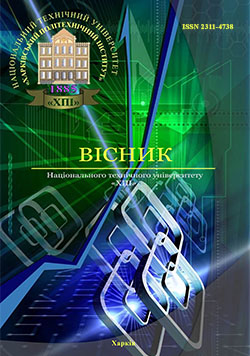USING THE METHOD OF SITUATIONAL ANALYSIS IN PROJECT MANAGEMENT TAKING INTO ACCOUNT SEASONALITY OF PRODUCTION
DOI:
https://doi.org/10.20998/2413-3000.2016.1174.9Keywords:
seasonality of production, fuzzy situational approach, project management, strategic decision makingAbstract
There have been proposed methods of fuzzy situational approach, providing decision-making in project management in enterprises with seasonal nature of production. The model of fuzzy graph situational project management in the investment phase, providing adequate and effective opportunity to describe the project taking into account seasonality and uncertainty in the tasks of planning and decision making. The conclusions about the choice of alternative strategic solutions for companies considering the seasonality of production based on the proposed fuzzy graph situational solutions that allow for the special factors such as the nature of the project and the environment; uncertainty in the design and environment; take account of the conditions of the process; and evaluate the results of actions and make choices alternatives for achieving the strategic objectives of the various activities of the enterprise, taking into account the seasonal factor.References
Prokopenko T. O., & Ladanuk A. P. (2014). Informasionaya model upravleniya tehnologicheskimi kompleksami neprerivnogo tipa v klasse organizadcionno-tehnicheskih sistem [The information model of management of technological complexes of continuous type in the class of organizational and technical systems]. Problemi upravleniya i informatiki - The International scientific and technical journal «Problems of management and informatics», 5, 64-70 [in Russian]
Ladanuk A. P., Shymigai D.A., & Boiko R.O. (2013). Sityacionnoe koordinirovanie podsistem tehnologicheskimi kompleksami neprerivnogo tipa [Situational coordination of subsystems of continuous technological complexes]. Problemi upravleniya i informatiki - The International scientific and technical journal «Problems of management and informatics», 4, 117-122 [in Russian]
Grebennik I. V., & Habarov A.U. (2003). Modelirovanie vneshnei sredi na effektivnost plana vipolneniya rabot [Simulation of the impact of the environment on efficiency of the work plan]. Sistemi obrabitki informacii - Information processing systems, 4(26) [in Russian].
Borisov V. V., Bichkov I. A., & Dement'ev A.V. (2002). Komputernaya poddergka slognih organizadcionno-tehnicheskih system [Computer support of complex organizational and technical systems]. Goryachaya linia-telecom, 154 [in Russian].
Udickii S. A., Muraldyan I. A., & Geltova L. V. (2008). Analiz slabostrukturirovanih problemnih sityacii v organizacionnih sistemah s primeneniem nedchetkih kognitivnih kart [The analysis of semi structured problem situations in organizational systems using fuzzy cognitive maps]. Pribori i sistemi. Upravlenie, control,diagnostika - Devices and systems. Management, monitoring, diagnostics, 3, 45-62 [in Russian].
Kylba V. V., Kononov D.A., Kovalevskii S. S., Kosyachenko S.A., Nigegorodcev P.M., & Chernov I.V. (2002). Scenarnii analiz dinamiki povedeniya cocialno-ekonomicheskih system [Scenario analysis of behavior dynamics of socio-economic systems] Instityt upravleniya im. V.A. Trapeznikova RAN. Moscow, 220 [in Russian].
Klikov Y. I., «et al». (1971). Semioticheskie osnovi sityacionno upravleniya [Semiotic foundations of situational management]. Moscow. Energiya, 171 [in Russian].
Zadeh L.A. (1989). Knowledge representation in fuzzy logic. IEEE Trans. Knowledge an Data Eng., 1., 89 – 100.
Borisov V. V., & Zernov M. M. (2009). Realizaciya sityacionnogo podhoda na osnove nechetkoiy ierarhicheskoiy sityacionno-sobitiiynoiy seti [Implementation of the situational approach based on the fuzzy hierarchical situational-event network]. Iskystvenniy intelekt I prinaytie resheniiy - Artificial Intelligence and decision-making, 1, 18-13 [in Russian].
Prokopenko T. O., & Ladanuk A. P. (2015). Informaciiyni tehnologii upravlinnya organizaciiyno-technologichnimi sistemami [Information technology of management of organizational and technological systems: monograph]. Cherkassi: Vertikal, vidavec Kandich S.G. 224 [in Russian].
Downloads
Published
Issue
Section
License
Copyright (c) 2016 Тетяна Олександрівна ПРОКОПЕНКО, Олена Віталіївна КОЛОМИЦЕВА

This work is licensed under a Creative Commons Attribution-NonCommercial-ShareAlike 4.0 International License.
Our journal abides by the Creative Commons copyright rights and permissions for open access journals.
Authors who publish with this journal agree to the following terms:
Authors hold the copyright without restrictions and grant the journal right of first publication with the work simultaneously licensed under a Creative Commons Attribution-NonCommercial-ShareAlike 4.0 International License (CC BY-NC-SA 4.0) that allows others to share the work with an acknowledgement of the work's authorship and initial publication in this journal.
Authors are able to enter into separate, additional contractual arrangements for the non-commercial and non-exclusive distribution of the journal's published version of the work (e.g., post it to an institutional repository or publish it in a book), with an acknowledgement of its initial publication in this journal.
Authors are permitted and encouraged to post their published work online (e.g., in institutional repositories or on their website) as it can lead to productive exchanges, as well as earlier and greater citation of published work.

